http://cptv.vo.llnwd.net/o2/ypmwebcontent/Chion/do%20120214%20STEM%20story2.mp3
The U. S. Bureau of Labor Statistics reports that many of the nation’s fastest-growing and highest paid jobs require training in science, technology, engineering and math, also known as the STEM fields. But in Connecticut, an estimated 1,000 manufacturing jobs remain unfilled because applicants lack the skills they need.
Many middle and high school students seem to lose interest in studying STEM subjects. For our second report in a week-long series, we explore why.
16-year old Charlotte Harrison says she’s always liked math.
"In math, there are usually multiple ways of doing things and you can discover them for yourself."
But that’s not how she feels about science.
"Everyone else has already discovered everything. You just have to memorize it."
She’s not alone. Jack Hammer teaches high school chemistry in Milford. At the start of this school year, he asked students if they were looking forward to chemistry.
"Out of 80 kids, maybe one answered that they were really looking forward to chemistry."
Hammer entered teaching a few years ago, after working as a computational chemist in a drug discovery lab. He says he finds two competing philosophies about how to teach science.
"One camp will say, well, you’ve got to learn a lot of the basics before you can actually do some science. But then there’s another camp, which I think is more persuasive to me personally, that if you get kids doing science, even it's fairly simple at first, you will capture their imagination."
Data show that American kids actually do well in math and science in the early years. But achievement and interest start to fall after 4th grade, drop precipitously in 8th and plummet in 12th.
Every four years, nations around the world participate in the Trends in International Mathematics and Science Study, or TIMSS. The U.S. ranks well below places like Hong Kong.
And as an example of why, Susan Palma with Litchfield’s Education Connection says there are differences in the way the two countries teach math.
"We cover every standard that is tested on the TIMSS test and Hong Kong covers 50%."
She describes the American approach to math education as broad and shallow, whereas Hong Kong takes a narrow and very deep dive approach. Palma says, sometimes, less is more.
"If you dig deep and teach a student in mathematics about a rectangle and all the attributes of a rectangle, parallel lines and the angles, those concepts apply to all shapes in geometry. So once you know how it works in the most basic shape, you apply it to a square. You apply it to a trapezoid."
And in the process learn to make connections and figure out how to solve problems.
American schools also tend to teach science and math separately from technology and engineering. That bothers Susan Palisano director of Education and Training for the Connecticut Center for Advanced Technology. She travels around the state promoting STEM education, and would like to see a more integrated approach.
"Science and math are the theoretical components. Technology and engineering are the applied components. And if you look at it that way and think about how you can contextualize science and math, STEM really is how it is supposed to be done."
And by doing that she says, American students would have an easier time making that crucial connection between what they’re learning in the classroom and what it might mean for them in real life.
"Because as kids get older they begin to think of what they’re going to be as they grow up, and if you don’t see how math and science fits into your life, to me that’s the explanation for why we lose kids."
Connecticut is home to a handful of specialty schools that focus on STEM education. 15-year old Robert Folsom attends New Haven’s Engineering and Science University Magnet School. He says he wants to be a mechanical engineer when he grows up, but still has to grapple with being labeled a science nerd.
"I’m there for a reason… Because this is my field. And most people be like, wow, you go to an engineering and science school. In their heart, they know he must be smart."
A study released last year by the National Research Council urges school districts to consider different educational models, but finds that good quality programs in traditional schools are equally as effective as specialty STEM programs.
The report also identifies key elements in successful STEM education – including teachers who understand how to teach it well, adequate instructional time, and access to STEM learning opportunities for traditionally under-served students.





